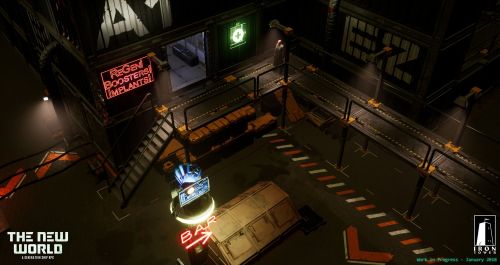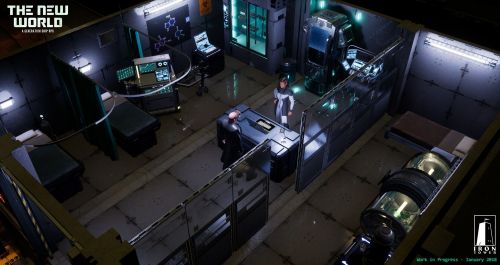- Joined
- Jan 28, 2011
- Messages
- 99,460















Tags: Colony Ship: A Post-Earth Role Playing Game; Iron Tower Studio; Nick Skolozdra; Vince D. Weller
Vault Dweller has published 2018's first development update for The New World. It's an important update, summarizing the previous year's work and announcing this year's plans - namely, the release of a combat demo. And yes, it includes our very first look at the actual game, in the form of two screenshots from the location known as the Pit. Behold:


2017 was a busy year: we did a lot of programming and animation work, produced a lot of art assets, defined locations (quests, places of interest, key characters), factions (leaders, relationships, goals), expanded the Pit’s quests, finalized the systems, and did a lot of work on the first two locations, so we started 2018 in a pretty good shape.
Our main goal for this year is to release a combat demo. It’s a major milestone as it’s practically a game in itself. We do that, it means we have the engine (fully customized for what we need), all systems except stealth, all art assets and animation, interface, and TONS of small things that take a lot of time. It’s a massive amount of work and it took us 5,5 years to reach this point with AoD. If we do it in 2 years this time around, it will mean that we’re right on schedule for 2020 release and give us 2 years to work on quests and locations.
What’s done:
- Map grid. In CSG, the tiles are aligned according to the surface angle and look better by not sticking into the ground;
- Non-combat and combat pathfinding. Two separate systems now, which allows smooth movement when exploring locations and good old tactical tile-to-tile movement in combat. Your combat path is also displayed with a nice spline, so no more uncertainty of "where exactly will my character move when I click here" kind;
- Map checking system that spawns warnings if certain map objects are not configured properly - this should decrease the amount of level-design bugs;
- Hierarchical item classes and visual item editor;
- Chargen;
- The flexible structure of character classes that allows adding new creature types with a different appearance, item slots and behavior easily. Implementing new creature type was a big task in AoD/Torque and required writing a lot of code from scratch every time;
- Party system. Better-looking party following, comparing to DR;
- Animation system based on a proper state machine this time. Animations blended with ragdoll, which should help to avoid situations like dead/knockdown characters sticking into the wall;
- Inventory system and screen. Inventory space is now grid-based;
- Character screen;
- Dialogue system, screen, and visual node-based dialogue editor;
- Cover system which provides defense bonuses based on cover type and angle of enemy's fire;
- Combat exit areas - special tiles, Fallout-style, that allow player to flee from combat and execute attached scripts;
- Overhead icons, more informative than in previous games, since they now can display progress bars, numbers, and other useful context-based information;
- Discrete hitbox/collision system. We got rid of the chaotic line of fire and attack results that were animation-based. In AoD/DR the cursor could report you that you are able to hit a target, but then, when you click, your enemy would turn around or scratch his butt, and your arrow could fly past him despite all the odds;
- RPG Camera, replicated from AoD, also includes optional orthographic projection mode;
- Doors (prototype, not final)
- Basic destructible environment;
- Building system (floors visibility, interior/exterior objects)
- Basic combat system (weapons, attack modes, THC calculation, hitting, missing, simple RNG) and combat flow (start, end, combat queue, detecting enemies, advancing turns). No status effects yet.
- Global and local quest variables and game states;
According to Iron Tower programmer Nick Skolozdra, it'll probably take around six additional months to complete the remaining gameplay features required for the combat demo. In the nearer future, expect an update presenting the game's armor system.
Vault Dweller has published 2018's first development update for The New World. It's an important update, summarizing the previous year's work and announcing this year's plans - namely, the release of a combat demo. And yes, it includes our very first look at the actual game, in the form of two screenshots from the location known as the Pit. Behold:


2017 was a busy year: we did a lot of programming and animation work, produced a lot of art assets, defined locations (quests, places of interest, key characters), factions (leaders, relationships, goals), expanded the Pit’s quests, finalized the systems, and did a lot of work on the first two locations, so we started 2018 in a pretty good shape.
Our main goal for this year is to release a combat demo. It’s a major milestone as it’s practically a game in itself. We do that, it means we have the engine (fully customized for what we need), all systems except stealth, all art assets and animation, interface, and TONS of small things that take a lot of time. It’s a massive amount of work and it took us 5,5 years to reach this point with AoD. If we do it in 2 years this time around, it will mean that we’re right on schedule for 2020 release and give us 2 years to work on quests and locations.
What’s done:
- Map grid. In CSG, the tiles are aligned according to the surface angle and look better by not sticking into the ground;
- Non-combat and combat pathfinding. Two separate systems now, which allows smooth movement when exploring locations and good old tactical tile-to-tile movement in combat. Your combat path is also displayed with a nice spline, so no more uncertainty of "where exactly will my character move when I click here" kind;
- Map checking system that spawns warnings if certain map objects are not configured properly - this should decrease the amount of level-design bugs;
- Hierarchical item classes and visual item editor;
- Chargen;
- The flexible structure of character classes that allows adding new creature types with a different appearance, item slots and behavior easily. Implementing new creature type was a big task in AoD/Torque and required writing a lot of code from scratch every time;
- Party system. Better-looking party following, comparing to DR;
- Animation system based on a proper state machine this time. Animations blended with ragdoll, which should help to avoid situations like dead/knockdown characters sticking into the wall;
- Inventory system and screen. Inventory space is now grid-based;
- Character screen;
- Dialogue system, screen, and visual node-based dialogue editor;
- Cover system which provides defense bonuses based on cover type and angle of enemy's fire;
- Combat exit areas - special tiles, Fallout-style, that allow player to flee from combat and execute attached scripts;
- Overhead icons, more informative than in previous games, since they now can display progress bars, numbers, and other useful context-based information;
- Discrete hitbox/collision system. We got rid of the chaotic line of fire and attack results that were animation-based. In AoD/DR the cursor could report you that you are able to hit a target, but then, when you click, your enemy would turn around or scratch his butt, and your arrow could fly past him despite all the odds;
- RPG Camera, replicated from AoD, also includes optional orthographic projection mode;
- Doors (prototype, not final)
- Basic destructible environment;
- Building system (floors visibility, interior/exterior objects)
- Basic combat system (weapons, attack modes, THC calculation, hitting, missing, simple RNG) and combat flow (start, end, combat queue, detecting enemies, advancing turns). No status effects yet.
- Global and local quest variables and game states;























